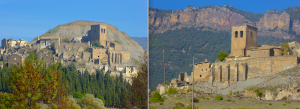
In Aragón driving from Pamplona to Jaca in the shadow of the Pyrenees on the N-240 there was a little mystery village on the left as I neared the end of the huge blue Yesa Reservoir corralling the waters of the Aragón River. The road to the village was rutted, dusty and meandering. No one was in sight and the stone houses were disassembling, falling back into the ground from whence they came.
But what happened to this particular village? Was this like the old village of Belchite also in Aragón? Belchite. Where in the late summer of 1937 a Spanish Civil War battle laid waste to the whole town, destroying it completely. Belchite the village that Franco designated as a monument of war to be left untouched, in ruins, as a lethal reminder of uprisings and militias.
Or was this like the old village of Openso? Openso in Galicia, like nearly 3,000 other Spanish villages depopulated by young people decamping to cities to make a modern leaving; leaving the old and ultimately the village to be no more. (Actually, just a year ago you could buy the hamlet of Lugo in Galicia, for a small price, if you performed the mandatory renovations of the four houses, mill, granary and barn.)
It wasn’t until later I discovered that this village was Esco and that the Yesa Reservoir is what happened. From the medieval times until the 1950s, it was considered one of the more beautiful villages in the area with productive arable soil on the banks of the Aragón River. In the mid-50s the fertile farmland was to become the Yesa Reservoir once a dam project was completed. With the agricultural roots and livelihood destroyed, people moved on.
Now, Esco sitting on a slight hill, the high Pyrenees beyond, is a reminder of a different Spain in a different age when rural villages and their centuries old rituals reigned.
You can stop and wander the ruins carefully if you are so inclined.


